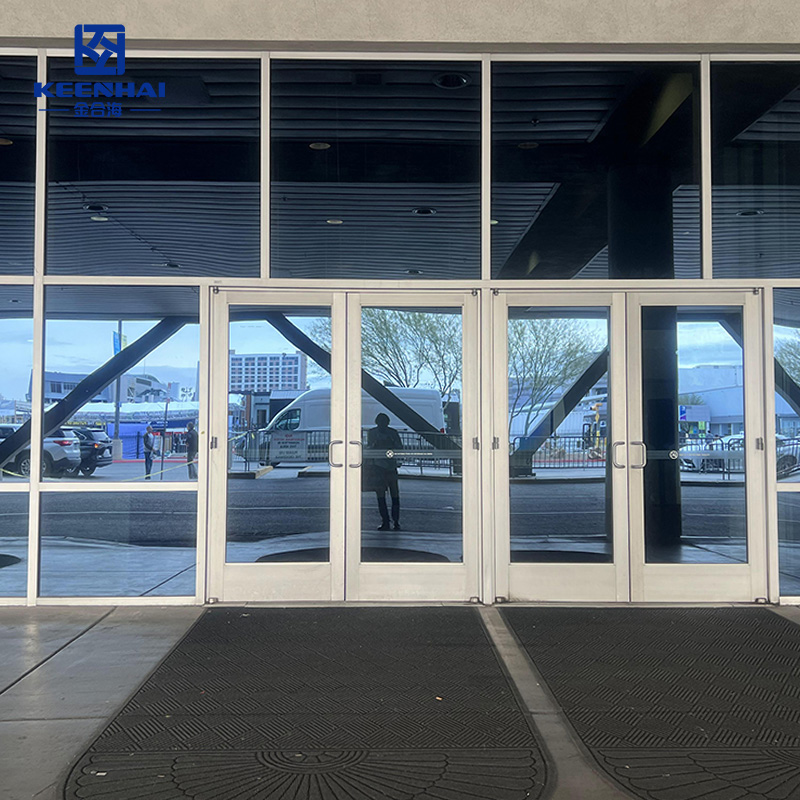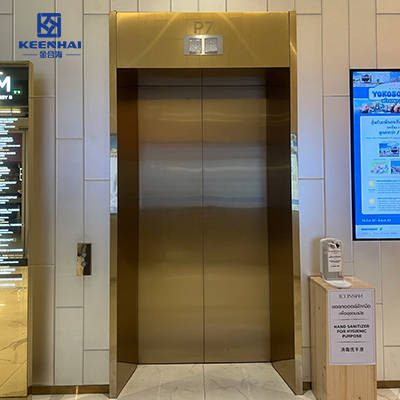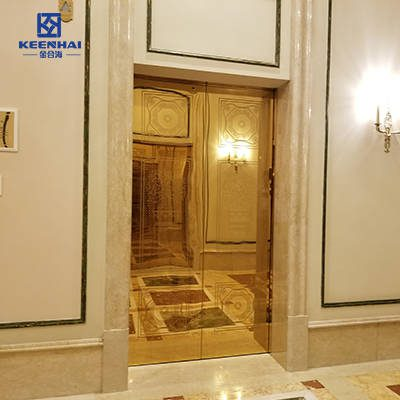The cost of stainless steel elevator doors varies widely depending on type, finish, and size. Standard brushed doors start around $1,200, while mirror-polished or PVD-coated panels can reach $5,000. Commercial projects often include installation and sensor integration, which adds $800–$3,500 per door.
1. Average Cost of Stainless Steel Elevator Doors
When architects or contractors plan an upgrade, one of the first questions that comes up is how much stainless steel elevator doors actually cost. For standard commercial installations, the average price ranges from $1,200 to $3,500 per opening, depending on finish quality, configuration, and size. You can find more design options and material variations on our stainless steel elevator door collection.
In real projects—like a downtown business tower or a five-star hotel renovation—door design and finish selection often determine the final price. A simple brushed surface is great for corporate offices, while mirror-polished or PVD-coated stainless steel fits luxury interiors that demand a premium look. The moment you touch a mirror-finished door, you’ll feel the difference—smooth, reflective, and distinctly high-end.
1.1 Typical Price Range by Door Type
Elevator doors are not priced by a single rule. The type of opening mechanism, the number of panels, and the aesthetic finish all influence cost. For example, center-opening doors—common in high-rise office buildings—require more precision alignment and thus cost more than single-slide types. The following table provides a quick market-based overview for 2025:
| Door Type | Finish Type | Average Price Range (USD per set) | Common Application |
|---|---|---|---|
| Single Slide | Brushed / Hairline | $1,200 – $2,000 | Residential / Small Office |
| Center Opening | Mirror / Etched | $2,000 – $3,000 | Mid-Range Commercial Building |
| PVD-Coated Finish | Gold / Bronze / Black | $3,000 – $5,000 | Luxury Hotel or Mall |
| Custom Design | Patterned or Colored PVD | $4,000 – $6,000 | Boutique / Corporate Lobby |
In practical cases, developers working on large buildings often order bulk batches of elevator doors, which reduces unit cost by roughly 10–15% due to streamlined production. For smaller boutique projects, prices stay higher because of customization and low-volume fabrication.
1.2 Cost Breakdown for Materials and Fabrication
The total cost doesn’t just come from the door panels. It’s a mix of several elements, and understanding them helps in budgeting and design planning. Generally, a typical stainless steel elevator door set involves these components:
-
Raw Material: The stainless steel sheets themselves—usually 304 or 316 grade—account for about 40–50% of the total price. 316-grade costs more but offers superior corrosion resistance, which is ideal for coastal or high-humidity environments.
-
Surface Treatment: Brushing, polishing, or applying PVD coating adds another 20–30%, depending on the desired finish. For example, a bronze PVD finish can cost twice as much as a basic brushed one because it requires vacuum coating technology.
-
Fabrication and Welding: Precision cutting, bending, and assembly take roughly 15–20% of the cost. Complex curved designs or etched patterns push this portion higher.
-
Labor and Installation: Typically 10–15% of the final budget goes into site installation, alignment, and fitting the panels with door frames.
Each of these steps directly impacts the final pricing structure.When comparing bids from different manufacturers, focus not only on the price per door but also on what’s included—surface treatment method, steel grade, and finish warranty. That’s what separates a true architectural-quality elevator door from a basic industrial version.

2. Key Factors That Affect the Price
When estimating the cost of custom stainless steel elevator doors for a commercial or residential project, several factors work together to shape the final price tag. From the door size and configuration to finish type and custom detailing, each decision can move the budget significantly. Developers planning modern upgrades often start with clear specifications, especially when dealing with architectural finishes like those from modern stainless elevator door systems.
2.1 Door Size and Configuration (Single vs. Double)
The first variable that drives cost is the door configuration. A single-slide door—commonly used in compact residential or low-rise office elevators—requires less steel material and simpler mechanics. In contrast, center-opening or double-panel doors need synchronized tracks and motors, increasing both the fabrication time and installation cost.
Here’s a straightforward comparison to give you an idea of how configuration impacts cost range and design complexity:
| Configuration Type | Opening Style | Average Price Range (USD) | Common Usage Scenario |
|---|---|---|---|
| Single-Slide | Opens to one side | $1,200 – $2,000 | Small offices, apartments |
| Double-Slide (Center Opening) | Panels open from the center | $2,200 – $3,500 | Commercial towers, hotels |
| Full Glass-Integrated Stainless Door | Custom mechanical frame | $3,500 – $5,000 | Luxury retail or corporate buildings |
For a hotel lobby veya shopping mall, double doors provide a more balanced aesthetic and smoother flow of guests, which justifies the higher investment. Architects often specify larger panel dimensions—sometimes up to 1.2 meters wide per leaf—to achieve a grander entrance effect.
2.2 Finish Options — Brushed, Mirror, PVD, and Etched
The yüzey bitirme is where design meets budget. A basic brushed stainless finish is cost-effective and widely used in high-traffic areas because it hides fingerprints well. Mirror-polished finishes, while visually impressive, take more polishing time and need protective packaging to avoid scratches during delivery.
If the goal is to achieve a luxury tone—like in a five-star hotel veya flagship retail elevator entrance—then PVD coatings come into play. PVD (Physical Vapor Deposition) applies a thin, ultra-hard layer that gives color options such as gold, bronze, or black titanium. These coatings not only elevate appearance but also make the doors resistant to corrosion and wear.
Etched stainless steel is another design-driven option, often featuring custom geometric or floral patterns. These finishes require acid etching or laser engraving, which adds roughly 15–25% to production costs.
2.3 Custom Design and Branding Requirements
Customization is the premium layer that transforms a simple door into an architectural centerpiece. In projects like corporate headquarters, luxury condominiums, veya high-end retail stores, clients often request engraved company logos, backlit panels, or integrated glass sections within the door design.
For example, one recent installation in a Shanghai hotel featured etched patterns with gold PVD trim, perfectly aligned with the building’s art-deco theme. The result was not only visually stunning but also a strong brand statement. Such design requirements can raise the total cost by 20–40%, depending on the complexity and pattern depth.
Manufacturers like Keenhai PVD stainless steel specialize in achieving these effects with high precision. Their ability to combine custom textures, precision laser work, and long-lasting coatings ensures that each elevator entrance feels unique and consistent across all floors.
In short, the key price drivers for elevator doors come down to configuration, finish quality, Ve custom detailing. Each of these adds value in aesthetics, durability, and brand perception, which is exactly why top architects and contractors never treat elevator doors as a small design decision—they treat them as part of the building’s identity.
3. Comparing Manual and Automatic Door Systems
When choosing between manual and automatic stainless steel elevator doors, understanding how each system operates can save both installation and long-term maintenance costs. Manual doors rely on physical mechanisms and user effort, while automatic systems integrate advanced sensors and motors to deliver a smoother and more efficient experience—especially in high-traffic environments like hotels, malls, or office towers.
3.1 Mechanical Components and Control Mechanisms
Manual elevator doors use spring-balanced hinges, lever arms, and guiding rollers to open and close reliably. Their design is simple, durable, and easy to maintain, making them ideal for smaller buildings or service lifts where automation isn’t essential. These systems depend entirely on human operation, and maintenance typically involves lubricating mechanical joints and checking alignment.
Automatic systems, on the other hand, use motorized drive units, control boards, and motion sensors to regulate the door’s opening and closing speed. The control logic ensures each movement is smooth, minimizing vibration and noise. In modern buildings, microprocessor-based controllers are used to synchronize the door’s motion with the elevator car’s position for enhanced passenger safety.
| Özellik | Manual Elevator Doors | Automatic Elevator Doors |
|---|---|---|
| Operation | Hand-operated | Motorized and sensor-controlled |
| Typical Use | Low-traffic or residential lifts | Commercial or public buildings |
| Maintenance | Low cost, mechanical only | Higher cost, requires technicians |
| Safety Control | Minimal | Includes obstruction detection |
| Lifespan | 10–15 years | 15–20 years with upgrades |
The mechanical precision of automatic models often justifies the higher cost, especially when paired with smart sensors and smooth-drive systems that reduce wear over time. For example, a hotel in Singapore upgraded its old manual doors to motorized stainless steel elevator doors, reducing guest wait time by nearly 25% while improving the building’s acoustic performance.
3.2 Automation Upgrades and Sensor Costs
Upgrading from manual to automatic doors involves integrating motion detectors, infrared safety curtains, and servo motor drives. These systems can detect when passengers or luggage are in the doorway, preventing sudden closures.
A standard automation retrofit includes:
-
Replacing the manual linkage with a low-noise motor drive.
-
Installing door sensors (usually infrared or radar-based).
-
Adding a control board that communicates with the elevator system’s main controller.
-
Calibrating sensor sensitivity to adjust for various lighting and passenger densities.
On average, automation upgrades cost between $2,000 and $4,500 per door set, depending on size, material finish, and sensor sophistication. The cost tends to be higher for stainless steel elevator doors with glass insets or custom finishes due to the additional precision alignment required.
For high-end projects such as luxury hotel lobbies or premium office elevators, architects often choose automatic stainless steel elevator entrances to create a modern, seamless look while maintaining safety compliance. These installations combine brushed or mirror finishes with concealed sensors that respond instantly to movement, blending technology and aesthetics into one continuous surface.
In summary, automatic door systems bring clear benefits in performance, safety, and user convenience, while manual systems remain a cost-effective, low-maintenance choice for limited-use settings. The best option ultimately depends on the building’s traffic flow, desired level of automation, and long-term maintenance strategy.
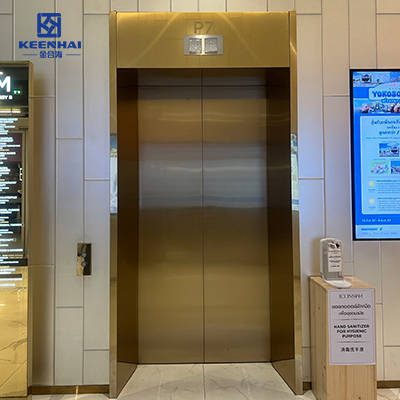
4. Additional Costs Beyond the Door Itself
When budgeting for stainless steel elevator doors, many buyers only consider the cost of the door panels and finish. However, the total investment includes several additional expenses — from installation labor to framing and delivery — that can significantly influence the overall price. These factors are especially important in commercial projects where precision fitting and aesthetic integration are key.
4.1 Installation and Labor Fees
The installation cost of elevator doors varies depending on complexity, building height, and required customization. For a typical commercial elevator system, installation generally accounts for 15–25% of the total cost. Labor charges include:
-
Removing existing door frames or preparing the shaft opening.
-
Mounting the door tracks and alignment systems to ensure smooth operation.
-
Connecting wiring and automation modules, if using motorized door systems.
-
Final calibration and testing to confirm sensor accuracy and door speed.
Projects involving custom stainless steel elevator doors often require specialized technicians familiar with stainless framing and PVD-coated finishes. These doors must be handled carefully during installation to prevent surface scratches or alignment errors that could affect smooth movement.
Labor costs can range from $800 to $1,500 per door for manual systems, while automated or sensor-integrated models can reach $2,000 to $3,500, depending on complexity and required precision. Skilled elevator installers often work with laser-guided tools to ensure that both panels meet at exact tolerances, reducing noise and preventing vibration during operation.
4.2 Delivery, Framing, and Site Preparation Expenses
Before the door can even be installed, several logistical and structural tasks add to the total budget. These include shipping, handling, and site readiness.
-
Delivery and Handling: Large stainless steel doors require protective crating and careful transport to avoid denting or bending. Depending on the region and door size, delivery can cost $200–$600 per unit.
-
Framing and Structural Reinforcement: Buildings with non-standard shaft openings often need custom framing brackets or stainless edge trims, adding another $300–$800 to the project.
-
Site Preparation: This covers leveling the threshold, wiring conduits, and ensuring sufficient clearance for sensors and safety edges. It’s especially crucial for stainless steel elevator entrances, which demand exact wall alignment and seamless joint integration for visual continuity.
| Cost Component | Tanım | Typical Range (USD) |
|---|---|---|
| Installation Labor | Skilled technicians, setup, calibration | $800–$3,500 |
| Delivery & Handling | Packaging, transport, and unloading | $200–$600 |
| Framing Materials | Structural adjustments and trims | $300–$800 |
| Site Preparation | Leveling, wiring, and finishing work | $400–$900 |
In short, while the base door price provides an initial estimate, total project costs often increase once installation, logistics, and site adjustments are factored in. Properly planning for these additional expenses helps avoid budget surprises and ensures a flawless final fit and finish.
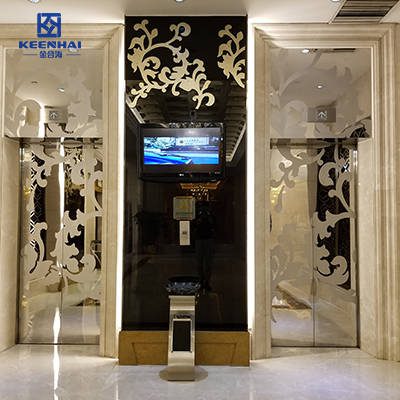
5. Maintenance and Long-Term Value Considerations
When investing in stainless steel elevator doors, thinking beyond the upfront cost is critical. Maintenance habits and expected lifespan directly influence long-term value, ensuring the doors remain both functional and visually appealing for years. Buildings with high traffic, like commercial offices, hotels, or shopping centers, benefit from proactive care to maximize durability and cost efficiency.
5.1 Surface Protection and Cleaning Frequency
The finish of stainless steel elevator doors determines how much attention they require. Brushed or hairline finishes hide fingerprints and minor scratches well, so cleaning can be done every 2–4 weeks using mild detergent and a soft cloth. Mirror-polished or PVD-coated surfaces, however, show smudges immediately and demand more frequent attention—often weekly—to maintain their pristine appearance.
Tips for prolonging the surface quality:
-
Use non-abrasive cleaners and microfiber cloths to prevent scratches.
-
Avoid harsh chemicals that can strip protective coatings.
-
Wipe along the grain direction on brushed finishes to maintain consistent appearance.
For elevators with glass inserts, an integrated cleaning routine ensures both steel and glass surfaces remain spotless without damaging edges or seals. Projects often integrate maintenance schedules into building management plans to reduce long-term repair costs.
5.2 Expected Lifespan and Cost Efficiency Over Time
A quality stainless steel elevator door typically lasts 15–20 years, depending on usage, environment, and maintenance diligence. While manual doors require minimal intervention, automatic or sensor-equipped doors involve occasional electronic checks and component replacements, such as motor drives or sensors, roughly every 7–10 years.
Here’s a practical way to understand long-term value:
| Door Type | Typical Lifespan | Maintenance Effort | Cost Efficiency |
|---|---|---|---|
| Manual Brushed Stainless | 15–20 years | Low | High, minimal ongoing cost |
| Automatic Brushed or Mirror Finish | 15–20 years | Moderate | Good, higher upfront cost but smooth operation |
| PVD-Coated or Custom Etched | 18–20 years | Moderate-High | Excellent visual value, moderate maintenance cost |
Investing in premium finishes and proper care ensures doors remain visually striking while avoiding early corrosion, scratches, or mechanical wear. Buildings that adhere to consistent cleaning and inspection routines often experience fewer replacements or repairs, making high-quality stainless steel doors not only an aesthetic choice but also a financially sound long-term investment.

